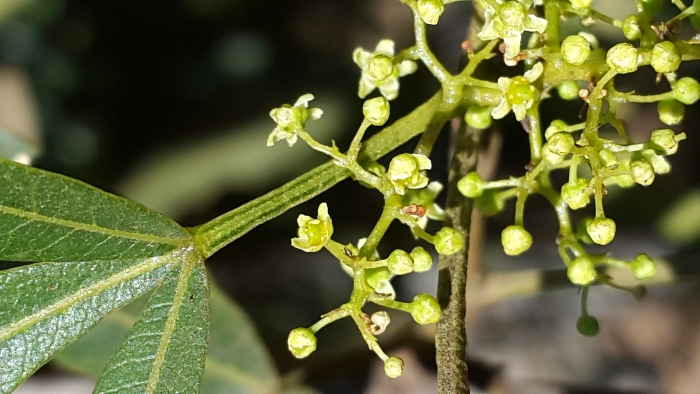African Sumac
(Searsia lancea)
African Sumac (Searsia lancea)
/
/

Paul venter
CC BY-SA 4.0
Image By:
Paul venter
Recorded By:
Copyright:
CC BY-SA 4.0
Copyright Notice:
Photo by: Paul venter | License Type: CC BY-SA 4.0 | License URL: https://creativecommons.org/licenses/by-sa/4.0 | Uploader: Paul venter | Publisher: Wikimedia Commons | Title: Searsia_lancea01.jpg | Notes: |





















































Estimated Native Range
Summary
Searsia lancea, commonly known as African Sumac, is an evergreen tree native to various habitats in Southern Africa, including savannas, bushveld, and dry riverbeds. It is a hardy species, tolerant of frost and drought, and can reach up to 8 meters in height with a 5-meter spread. The tree is dioecious, meaning individual plants are either male or female. African Sumac has a graceful, weeping form and features dark, fissured bark that provides a striking contrast to its long, slender, hairless, dark-green, trifoliate leaves with smooth margins. It produces small yellow flowers, which, on female trees, are followed by bunches of small yellow-green flattish fruits that are enjoyed by birds. The fruits were historically used to make a type of beer through fermentation.
African Sumac is valued for its weeping form and the shade it provides. It is often used in urban landscapes, as a windbreak, and for erosion control due to its extensive root system. This tree is well-suited to xeriscaping and is low maintenance once established. It thrives in full sun to part shade and prefers well-drained soils. While it is drought-resistant, occasional deep watering during extended dry periods will benefit the tree. Gardeners should be cautious, as Searsia lancea can become invasive outside its native range, so it is essential to check local regulations before planting.CC BY-SA 4.0
African Sumac is valued for its weeping form and the shade it provides. It is often used in urban landscapes, as a windbreak, and for erosion control due to its extensive root system. This tree is well-suited to xeriscaping and is low maintenance once established. It thrives in full sun to part shade and prefers well-drained soils. While it is drought-resistant, occasional deep watering during extended dry periods will benefit the tree. Gardeners should be cautious, as Searsia lancea can become invasive outside its native range, so it is essential to check local regulations before planting.CC BY-SA 4.0
Plant Description
- Plant Type: Tree
- Height: 20-30 feet
- Width: 15-30 feet
- Growth Rate: Slow, Moderate
- Flower Color: N/A
- Flowering Season: Summer
- Leaf Retention: Evergreen
Growth Requirements
- Sun: Full Sun, Part Shade
- Water: High
- Drainage: Fast, Medium
Common Uses
Erosion Control, Fire Resistant, Low Maintenance, Street Planting
Natural Habitat
Native to various habitats in Southern Africa, including savannas, bushveld, and dry riverbeds
Other Names
Common Names: Willow Rhus, Karee, Karree
Scientific Names: , Rhus lancea, Searsia lancea, Rhus viminalis, Rhus fragrans, Rhus denudata, Toxicodendron lanceum,
GBIF Accepted Name: Searsia lancea (L.fil.) F.A.Barkley